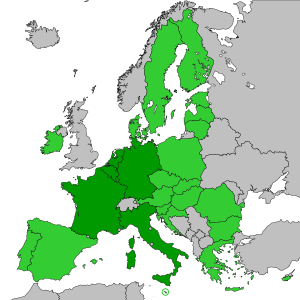EURATOM Cooperation Act of 1958 facts for kids
 |
|
| Long title | An Act to provide for cooperation with the European Atomic Energy Community. |
|---|---|
| Nicknames | European Atomic Energy Community Cooperation Act |
| Enacted by | the 85th United States Congress |
| Effective | August 28, 1958 |
| Citations | |
| Public law | 85-846 |
| Statutes at Large | 72 Stat. 1084 |
| Codification | |
| Titles amended | 42 U.S.C.: Public Health and Social Welfare |
| U.S.C. sections created | 42 U.S.C. §§ 2291–2296 |
| Legislative history | |
|
|
The EURATOM Cooperation Act of 1958 was a special law in the United States. It created a partnership between the European Atomic Energy Community (called EURATOM) and the United States. This law was part of a bigger plan to help countries in Europe build power plants using nuclear power technology.
The main goal was to set up a "joint program." This program would help build nuclear power plants in EURATOM countries. It also created a research and development program for nuclear energy. The law was signed by President Dwight D. Eisenhower on August 28, 1958.
Contents
What the Act Did
The EURATOM Cooperation Act allowed for several important things to happen between EURATOM and the United States.
Key Definitions
To understand the Act, it's helpful to know what some words meant in this law:
- The Community meant the European Atomic Energy Community (EURATOM). This group included Belgium, France, Italy, Luxembourg, Netherlands, and West Germany.
- The Commission meant the Atomic Energy Commission (AEC). This was a U.S. government agency.
- Joint program was the name for the big project where EURATOM and the U.S. worked together. Their goal was to build nuclear power plants in EURATOM countries. They aimed for about 1 million kilowatts of electricity by the end of 1963.
- Other words in the Act had the same meaning as in the earlier Atomic Energy Act of 1954.
Research and Development
The Act set aside $3 million for a special research and development program. This money was for studying and improving the types of nuclear reactors chosen for the joint program. The U.S. Atomic Energy Commission could sign contracts for up to five years for this research. EURATOM also had to put in an equal amount of money for this shared research.
Helping with Costs (Guarantee Contracts)
The Act allowed the Atomic Energy Commission to make "guarantee contracts." These were like promises to help cover certain costs for the nuclear power plants built under the joint program. The total amount of these promises could not go over $90 million.
These guarantees were meant to make sure that the costs for preparing and moving nuclear fuel for the reactors were not too high. The Commission wanted to encourage American companies to build reactor parts and fuel. The guarantees followed an agreement between the U.S. government and EURATOM.
Selling or Leasing Nuclear Material
The Act allowed the U.S. to sell or lease nuclear materials to EURATOM. This included:
- About 30,000 kilograms (66,000 pounds) of Uranium-235. Uranium-235 is a special type of uranium used as fuel in nuclear reactors.
- About 1 kilogram (2.2 pounds) of plutonium. Plutonium is another important material used in nuclear energy.
If EURATOM didn't pay for the nuclear material right away, the U.S. government would have the first claim on it.
Buying Back Nuclear Materials
The Atomic Energy Commission was also allowed to buy back special nuclear materials from EURATOM. This included plutonium and Uranium-233 that were produced in the reactors built under the joint program. The U.S. could buy up to 4,100 kilograms (9,000 pounds) of plutonium, but only for peaceful uses.
These contracts to buy back materials could last for up to ten years of a reactor's operation. The price paid would not be more than the Commission's standard price for such materials at the time of delivery.
U.S. Not Responsible for Damages
The Act stated that the United States government would not be responsible for any damages or problems that might happen because of the joint program. This meant that if something went wrong, the U.S. government would not be held liable. However, it also said that people still had their rights under the Atomic Energy Act of 1954. The U.S. government would take steps, like making special agreements, to make sure this rule was followed.
Changes to the Act
The EURATOM Cooperation Act of 1958 was updated several times over the years. Here are some of the main changes:
| Date of Change | Public Law Number | U.S. President |
|---|---|---|
| September 6, 1961 | P.L. 87-206 | John F. Kennedy |
| August 1, 1964 | P.L. 88-394 | Lyndon B. Johnson |
| December 14, 1967 | P.L. 90-190 | Lyndon B. Johnson |
| August 14, 1973 | P.L. 93-88 | Richard M. Nixon |


